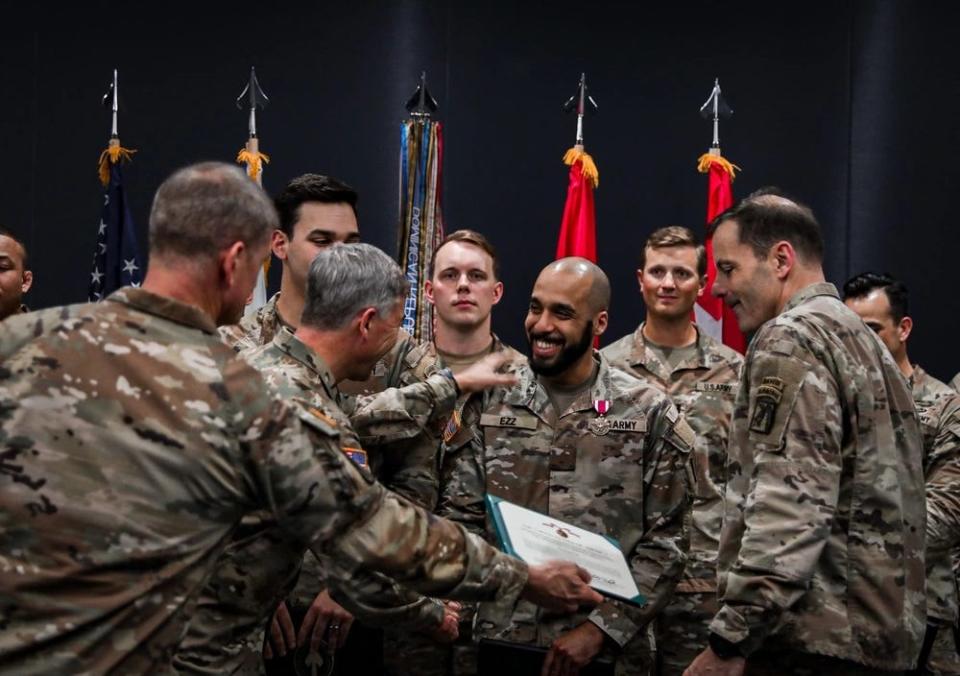Did Army soldiers invent a device to prevent mold in barracks?
- Oops!Something went wrong.Please try again later.
Service members were in Florida last week to present their ideas to a panel of military, government, industry, academic and investor judges in a “Shark Tank”-style competition series known as “Dragon’s Lair.”
The latest competition was cohosted March 29 by the U.S. Special Operations Command and the 18th Airborne Corps at the University of South Florida’s Research and Innovation Park in Tampa, Florida.
Kathi Vidal, director of the U.S. Patent and Trade Office, and the U.S. undersecretary of Commerce for intellectual property were among the judges.
“It’s all about people who are the boots on the ground identifying problems and being creative to come up with solutions," Vidal said in a phone interview last week from Florida.

After being selected from among 80 other Department of Defense ideas and competing against seven finalist teams, 1st Lt. Chris Aliperti and Pvt. Salem Ezz, of the 3rd Infantry Division at Fort Stewart, Georgia, were named the latest winners for their mold conditions awareness tool.
The tool uses sensors to detect temperature and humidity levels within barracks to identify early signs of mold and immediately uploads that data online for military leaders and barracks managers to see.
In August, senior leaders at Fort Bragg moved 1,189 soldiers from aging Smoke Bomb Hill barracks after determining the living quarters for single soldiers had issues with heating, ventilation systems and moisture levels.
In early January 2021, mold was found and remediated in two 82nd Airborne Division barracks, while mold was also found in two barracks under the 1st Special Forces Command's 528th Special Operations Sustainment Brigade in October 2020.
More: More than 1,200 Fort Bragg soldiers to be relocated because of barrack conditions
“We know that mold grows when it’s hot and humid, and it gets cleaned after the mold grows,” Aliperti said last week. “This tool gets ahead of the problem before the mold gets a chance to grow.”
He said Ezz spent months developing the tool that is now being beta tested in barracks on Fort Stewart.
Alipertie said the tool used 144 sensors that monitored conditions in a barracks building at Fort Stewart while the soldiers were at the National Training Center in California.
For their idea, Aliperti and Ezz each were presented with the Meritorious Service Medal, will be allowed to attend a military school of choice, and will receive the support and resources from U.S. Special Operations Command and the 18th Airborne Corps to implement their idea across the Department of Defense.
Jump logs
Among the teams to represent Fort Bragg were 82nd Airborne Division soldiers 1st Lt. Graham Gifford, Sgt. 1st. Class Christopher Slone and Staff Sgt. John Templeton.
The trio’s idea was to digitize airborne logs.
Gifford said the system currently uses printed-out manifests to record which soldiers entered an aircraft and which paratroopers jumped out.
The manifest, Gifford said, could have up to 1,000 to 1,200 paratroopers' names on it, and it’s up to a unit representative to verify which paratroopers in their company jumped and handwrite that information in a three-ring binder.
He and his fellow paratroopers presented an idea that proposed updating the logs to a digital system that would maintain the jump records and allow paratroopers to view and search their own records.
GPS protection and other ideas
Also presenting an idea from Fort Bragg was Capt. Micael Counihan, with the 18th Field Artillery Brigade, who created a protection device for antennas on global positioning systems.
Counihan said low-powered signals can sometimes be “overpowered,” by any other devices on the same frequency.
The two-ring copper mesh device Counihan developed would prevent “adversaries from jamming devices.”
An initial prototype was tested in the fall, and the latest prototype will be tested in the next few weeks, he said.
Other competitors and ideas presented included:
• Staff Sgt. Richard Smith, with the 7th Special Forces Group at Elgin Air Force Base in Florida, presented a future unmanned aircraft system operator concept.
• Air Force Tech Sgt. Khalil Bashir, Master Sgt. Keli Manglona, and Staff Sgt. Brett Doyle, with the 27th Special Operations Maintenance Group from Cannon Air Force Base, New Mexico, created an AC-130 munition loading winch.
• Staff Sgt. Austin Lehmann, of the 101st Airborne Division at Fort Campbell, Kentucky, created a 60 mm mortar sight.
• Maj. Patrick Kerins, Maj. Kyle Stilwell and 1st Sgt. Bill Wilder, with the 3rd Infantry Division, created an enhanced ground reconnaissance initiative.
Staff writer Rachael Riley can be reached at rriley@fayobserver.com or 910-486-3528.
This article originally appeared on The Fayetteville Observer: Soldiers develop tool to detect mold in barracks

